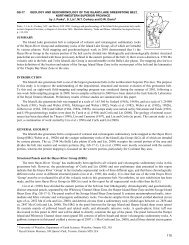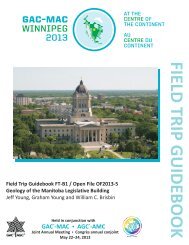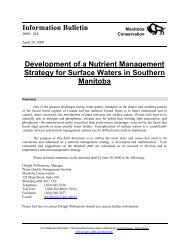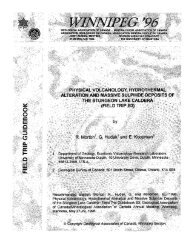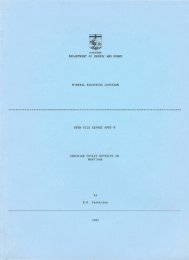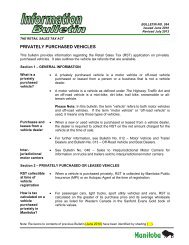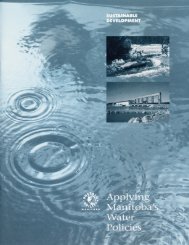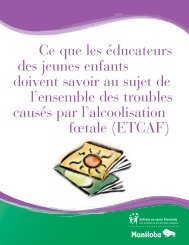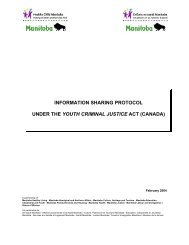Trapping Guide - Government of Manitoba
Trapping Guide - Government of Manitoba
Trapping Guide - Government of Manitoba
You also want an ePaper? Increase the reach of your titles
YUMPU automatically turns print PDFs into web optimized ePapers that Google loves.
TRAPPING GUIDERights-based harvestersThe Rights and Responsibilities <strong>of</strong> First Nations PeopleWho Trap in <strong>Manitoba</strong>The Natural Resources Transfer Agreement (1930), which forms part <strong>of</strong>The Constitution Act (1982), provides that First Nations people havethe right to trap for food:• at all seasons <strong>of</strong> the year on all unoccupied Crown lands• on any other lands to which they may have the right <strong>of</strong> accessRecognizing the Treaty and Constitutional rights <strong>of</strong> First Nationspeople, <strong>Manitoba</strong> Conservation and Water Stewardship recognizesthat status Indian people, when trapping for food or traditionalceremonial purposes on lands where they have a right <strong>of</strong> access:• do not require licences• are not restricted to specific seasons• are not restricted to limits unless there restrictions that areintended for conservation purposes• may share the meat and fur with non-status family membersliving in the same residence• are not subject to equipment restrictions including those asspecified under EU Regulation #3254/91 or more commonlyknown as the Agreement on International Humane <strong>Trapping</strong>StandardsFirst Nations people generally have the right <strong>of</strong> access to trapfor food or traditional ceremonial purposes within:• Indian Reserves, Wildlife Management Areas, Provincial Forests,areas <strong>of</strong> Provincial Parks where licensed trapping is permitted,unoccupied Crown lands, and other Crown lands where licensedhunting or trapping is permitted• private land with the permission <strong>of</strong> the landowner or occupant• federal land, such as PFRA community pastures are opened tothe public for trapping, or with the permission <strong>of</strong> the PastureManagerNo person (status or non-status) may trap within:• Riding Mountain National Park, Birds Hill Provincial Park,Beaudry Provincial Heritage Park or Pembina Valley ProvincialPark• areas <strong>of</strong> Provincial Parks closed to all hunting or trapping• Wildlife Refuges and most Ecological Reserves• areas closed to all persons for specific conservation purposesResponsibilitiesWith these rights come responsibilities such as conservation andsafety requirements. All First Nations trappers have a responsibilityto ensure that their actions in taking furbearers do not reduce thesustainability <strong>of</strong> furbearer populations.The rights <strong>of</strong> status Indian people are subject to conservationmeasures and other restrictions that do not unduly infringe on foodharvesting. First Nation trappers may not:• trap protected furbearers for which trapping is prohibited suchas wolverine in the open trapping areas <strong>of</strong> <strong>Manitoba</strong>• waste or abandon furbearers• sell, trade or give away the meat, fur or any other part <strong>of</strong>furbearers taken under status Indian trapping rights, except thatfood may be given to another First Nations person• sell the pelt <strong>of</strong> a furbearer unless it was caught under theauthority <strong>of</strong> a <strong>Trapping</strong> Licence and all trapping regulationswere followedSafety RequirementsMany safety restrictions contained in resource managementlegislation apply to all trappers in <strong>Manitoba</strong>, including First Nationstrappers. No trapper may:• use trapping methods that are careless, unsafe or dangerous toany person• discharge a rifle or shotgun at night where it is dangerous to do so• hunt from a provincial road or provincial trunk highway ordischarge a bow or firearm from such a road or highway, orshoot along or across such a road or highway (including theroad allowance) for the purpose <strong>of</strong> taking a furbearer• discharge a centrefire rifle, muzzleloading firearm or shotgunusing a slug from a public road within a municipality or localgovernment district, or shoot along or across such a road• carry a loaded firearm in a vehicle or discharge a firearmfrom a vehicleIt is also recommended that all trappers:• wear hunter orange clothes when trapping during the time<strong>of</strong> year when there are big game hunters in the same areaor where there may be other people using the same area forother purposes• take a <strong>Manitoba</strong> Trapper Education course14



